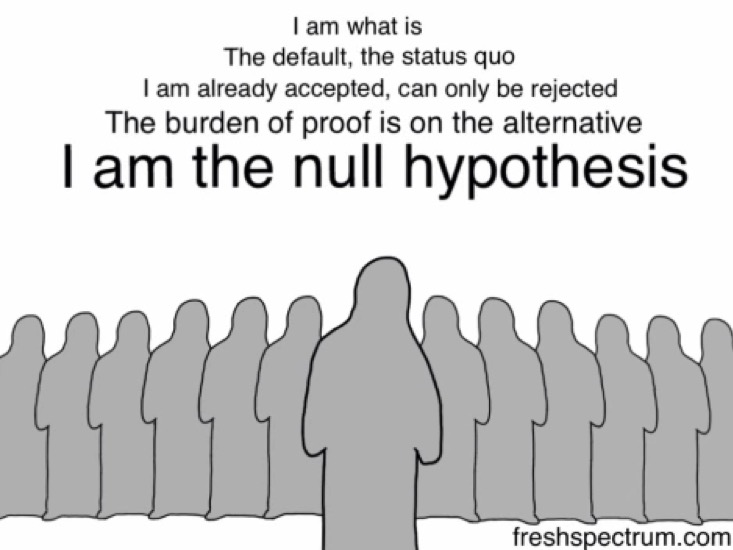Kind I and sort II errors occur once you
erroneously spot winners in your experiments or fail to notice them. With each
errors, you find yourself going with what seems to work or not. And never with the
actual outcomes.
Misinterpreting take a look at outcomes doesn’t simply end in misguided optimization efforts however also can derail your optimization program in the long run.
The most effective time to catch these errors is earlier than you even make them! So let’s see how one can keep away from working into kind I and sort II errors in your optimization experiments.
However earlier than that, let’s have a look at the null speculation… as a result of it’s the misguided rejection or non-rejection of the null speculation that causes kind I and sort II errors.
The Null Speculation: H0
Once you hypothesize an experiment, you don’t
instantly leap to recommend that the proposed change will transfer a sure metric.
You begin by saying that the proposed change
received’t affect the involved metric in any respect — that they’re unrelated.
That is your null speculation (H0). H0 is
all the time that there isn’t a change. That is what you consider, by default… till
(and if) your experiment disproves it.
And your various speculation (Ha or H1) is
that there’s a optimistic change. H0 and Ha are all the time mathematical opposites.
Ha is the one the place you anticipate the proposed change to make a distinction, it’s
your various speculation — and that is what you’re testing together with your
experiment.
So, as an illustration, should you needed to run an
experiment in your pricing web page and add one other cost technique to it, you’d
first kind a null speculation saying: The
extra cost technique may have no affect on gross sales. Your alternate
speculation would learn: The extra
cost technique WILL enhance gross sales.
Working an experiment is, the truth is, difficult the null speculation or the established order.


Kind I and sort II errors occur once you erroneously reject or fail to reject the null speculation.
Understanding Kind I Errors
Kind I errors are often called false positives or
Alpha errors.
In a sort I error occasion of speculation
testing, your optimization take a look at or experiment *APPEARS TO BE SUCCESSFUL* and also you (erroneously) conclude that the
variation you’re testing is doing in another way (higher or worse) than the
authentic.
In kind I errors, you see lifts or dips — which might be solely non permanent and received’t doubtless
preserve in the long run — and find yourself rejecting your null speculation (and
accepting your various speculation).
Erroneously rejecting the null speculation can
occur for numerous causes, however the main one is that of the follow of peeking (i.e., your outcomes
within the interim or when the experiment’s nonetheless working). And calling the checks
before the set stopping standards is reached.
Many testing methodologies discourage the
follow of peeking as interim outcomes might result in improper
conclusions leading to kind I errors.
Right here’s how you could possibly make a sort I error:
Suppose you’re optimizing your B2B web site’s
touchdown web page and hypothesize that including badges or awards to it is going to cut back
your prospects’ anxiousness, thereby rising your kind fill price (leading to
extra leads).
So your null speculation for this experiment
turns into: Including badges has no affect on
kind fills.
The stopping standards for such an experiment is normally a sure interval and/or after X conversions occur on the set statistical significance stage. Conventionally, optimizers attempt to hit the 95% statistical confidence mark as a result of it leaves you with a 5% probability of creating the sort I error that’s thought of low sufficient for many optimization experiments. Usually, the upper this metric is, the decrease are the probabilities of making kind I errors.
The extent of confidence that you just purpose for determines what your chance of getting a sort I error (α) shall be.
So should you purpose for a 95% confidence stage, your worth for α turns into 5%. Right here, you settle for that there’s a 5% probability that your conclusion might be improper.
In distinction, should you go along with a 99% confidence stage together with your experiment, your chance of getting a sort I error drops to 1%.
Let’s
say, for this experiment, that you just get too impatient and as a substitute of ready to your experiment to finish, you
have a look at your testing instrument’s dashboard (peek!) only a day into it. And also you
discover an “obvious” raise — that your kind fill price has gone up by a whopping
29.2% with a 95% stage of confidence.
And BAM…
… you cease your experiment.
… reject the null speculation (that badges had
no affect on gross sales).
… settle for the choice speculation (that
badges boosted gross sales).
… and run with the model with the awards
badges.
However as you measure your leads over the month,
you discover the quantity to be practically corresponding to what you reported with the
authentic model. The badges didn’t matter a lot in any case. And that the null
speculation was most likely rejected in useless.
What occurred right here was that you just ended your experiment too quickly and rejected the null speculation and ended up with a false winner — making a sort I error.
Avoiding Kind I Errors in Your Experiments
One certain manner of decreasing your probabilities of
hitting a sort I error goes with the next confidence stage. A 5%
statistical significance stage (translating to a 95% statistical confidence
stage) is appropriate. It’s a guess most optimizers would safely make as a result of,
right here, you’ll fail within the unlikely 5% vary.
Along with setting a excessive confidence stage, working your checks for lengthy sufficient is essential. Check period calculators can inform you for the way lengthy it’s essential to run your take a look at (after factoring in issues like a specified impact dimension amongst others). In case you let an experiment run its meant course, you considerably cut back your probabilities of encountering the sort 1 error (given you’re utilizing a excessive confidence stage). Ready till you attain statistically vital outcomes ensures that there’s solely a low probability (normally 5%) that you just rejected the null speculation erroneously and dedicated a sort I error. In different phrases, use a very good pattern dimension as a result of that’s essential to getting statistically vital outcomes.
Now that was all about kind I errors which might be associated to the extent of confidence (or significance) in your experiments. However there may be one other kind of error too that may creep into your checks — the sort II errors.
Understanding Kind II Errors
Kind II errors are often called false negatives or
Beta errors.
In distinction to the sort I error, within the
occasion of a sort II error, the experiment *APPEARS TO BE UNSUCCESSFUL (OR INCONCLUSIVE)* and also you
(erroneously) conclude that the variation you’re testing isn’t doing any
totally different from the unique.
In kind II errors, you fail to spot the true
lifts or dips and find yourself failing to reject the null speculation and rejecting
the choice speculation.
Right here’s how you could possibly make the sort II error:
Going again to the identical B2B web site from above…
So suppose this time you hypothesize that
including a GDPR compliance disclaimer prominently on the prime of your kind will
encourage extra prospects to fill it out (leading to extra leads).
Subsequently, your null speculation for this
experiment turns into: The GDPR compliance
disclaimer doesn’t affect kind fills.
And the choice speculation for a similar
reads: The GDPR compliance disclaimer
ends in extra kind fills.
A take a look at’s statistical energy determines how properly it might probably detect variations within the efficiency of your authentic and challenger variations, ought to any deviations exist. Historically, optimizers attempt to hit the 80% statistical energy mark as a result of the upper this metric is, the decrease are the probabilities of making kind II errors.
Statistical energy takes a price between 0 and 1 (and is commonly expressed in %) and controls the chance of your kind II error (β); it’s calculated as: 1 – β
The upper the statistical energy of your take a look at, the decrease would be the chance of encountering kind II errors.
So if an experiment has a statistical energy of 10%, then it may be fairly vulnerable to a sort II error. Whereas, if an experiment has a statistical energy of 80%, will probably be far much less prone to make a sort II error.
Once more, you run your take a look at, however this time you
don’t discover any vital uplift in your kind fills. Each variations report
close to comparable conversions. Due to which, you cease your experiment and
proceed with the unique model with out the GDPR compliance disclaimer.
Nonetheless, as you dig deeper into your leads
knowledge from the experiment interval, you discover that whereas the variety of leads from
each variations (the unique and the challenger) appeared an identical, the GDPR
model did get you a very good, vital uptick within the variety of leads from
Europe. (In fact, you could possibly have used viewers concentrating on to indicate the
experiment solely to the leads from Europe – however that’s one other story.)
What occurred right here was that you just ended your take a look at too early, with out checking should you had attained enough energy — making a sort II error.
Avoiding Kind II Errors in Your Experiments
To keep away from kind II errors, run checks with excessive
statistical energy. Attempt to configure your experiments so you may hit a minimum of
the 80% statistical energy mark. That is a suitable stage of statistical
energy for many optimization experiments. With it, you may be certain that in 80% of
the instances, a minimum of, you’ll accurately reject a false null speculation.
To do that, you have to have a look at the elements
that add to it.
The most important of those is the pattern dimension (given an noticed impact dimension). The pattern dimension ties on to the facility of a take a look at. An enormous pattern dimension means a excessive energy take a look at. Underpowered checks are very weak to kind II errors as your probabilities of detecting variations within the outcomes of your challenger and authentic variations cut back drastically, particularly for low MEIs (extra on this beneath). So to keep away from kind II errors, await the take a look at to build up enough energy to reduce kind II errors. Ideally, for many instances, you’d wish to attain an influence of a minimum of 80%.
One other issue is the Minimal Impact of Curiosity (MEI) that you just goal to your
experiment. MEI (additionally known as MDE) is the minimal magnitude of the distinction
that you’d wish to detect in your KPI in query. In case you set a low MEI
(eyeing a 1.5% uplift, for instance), your probabilities of encountering the sort II
error enhance as a result of detecting small variations wants considerably larger
pattern sizes (to achieve enough energy).
And at last, it’s essential to notice that there tends to be an inverse relationship between the chance of creating a sort I error (α) and the chance of creating a sort II error (β). For instance, should you lower the worth of α to decrease the chance of creating a sort I error (say you set α at 1%, which means a confidence stage of 99%), the statistical energy of your experiment (or its capacity, β, of detecting a distinction when it exists) finally ends up lowering too, thereby rising your chance of getting a sort II error.
Being Extra Accepting of Both of the Errors: Kind I and II (& Putting a Stability)
Reducing the chance of 1 kind of error
will increase that of the opposite kind (given all else stays the identical).
And so you have to take the decision on what error
kind you could possibly be extra tolerant towards.
Making a sort I error, on one hand, and
rolling out a change for all of your customers might price you conversions and income
— worse, might be a conversion killer too.
Making a sort II error, alternatively, and
failing to roll out a successful model for all of your customers might, once more, price you
the conversions you could possibly have in any other case received.
Invariably, each the errors come at a price.
Nonetheless, relying in your experiment, one
is perhaps extra acceptable to you over the opposite.
Usually, testers discover the kind
I error about 4 instances extra severe than the sort II error.
In case you’d prefer to take a extra balanced strategy, statistician Jacob Cohen suggests you must go for a statistical energy of 80% that comes with “an affordable steadiness between alpha and beta danger.” (80% energy can be the usual for many testing instruments.)
And so far as the statistical significance is anxious, the usual is ready at 95%.
Principally, it’s all about compromise and the danger stage that you just’re prepared to tolerate. In case you needed to actually decrease the probabilities of each the errors, you could possibly go for a confidence stage of 99% and an influence of 99%. However that will imply you’d be working with impossibly large pattern sizes for intervals seeming eternally lengthy. In addition to, even then you definitely’d be leaving some scope for errors.
Each on occasion, you WILL conclude an experiment wrongly. However that’s a part of the testing course of — it takes some time to grasp A/B testing statistics. Investigating and retesting or following up in your profitable or failed experiments is one solution to reaffirm your findings or uncover that you just made a mistake.
Initially revealed Might 28, 2020 – Up to date July 17, 2024
Cell studying?
Authors
Editors

Carmen Apostu
In her position as Head of Content material at Convert, Carmen is devoted to delivering top-notch content material that folks can’t assist however learn via. Join with Carmen on LinkedIn for any inquiries or requests.




